Leadership Presentation Feedback Report: Satya Nadella Case Study
VerifiedAdded on 2022/10/01
|5
|1363
|26
Report
AI Summary
This report provides a comprehensive feedback analysis of a group presentation focused on Satya Nadella, the CEO of Microsoft. The presentation covered various aspects of Nadella's career, including his rise from India's middle class, his leadership characteristics, and the lessons that can be learned from his leadership style. The report includes individual feedback on each presenter, highlighting their strengths in areas such as verbal and non-verbal communication, public speaking skills, and presentation style. It also provides a self-reflection component, where the author critically evaluates their own contributions to the group process and their presentation performance. The report analyzes the use of visual aids, audience engagement, and the overall effectiveness of the presentation in conveying key information about Satya Nadella's leadership and its impact on Microsoft's transformation. The feedback emphasizes the importance of clear communication, strong presentation skills, and the ability to engage the audience effectively.
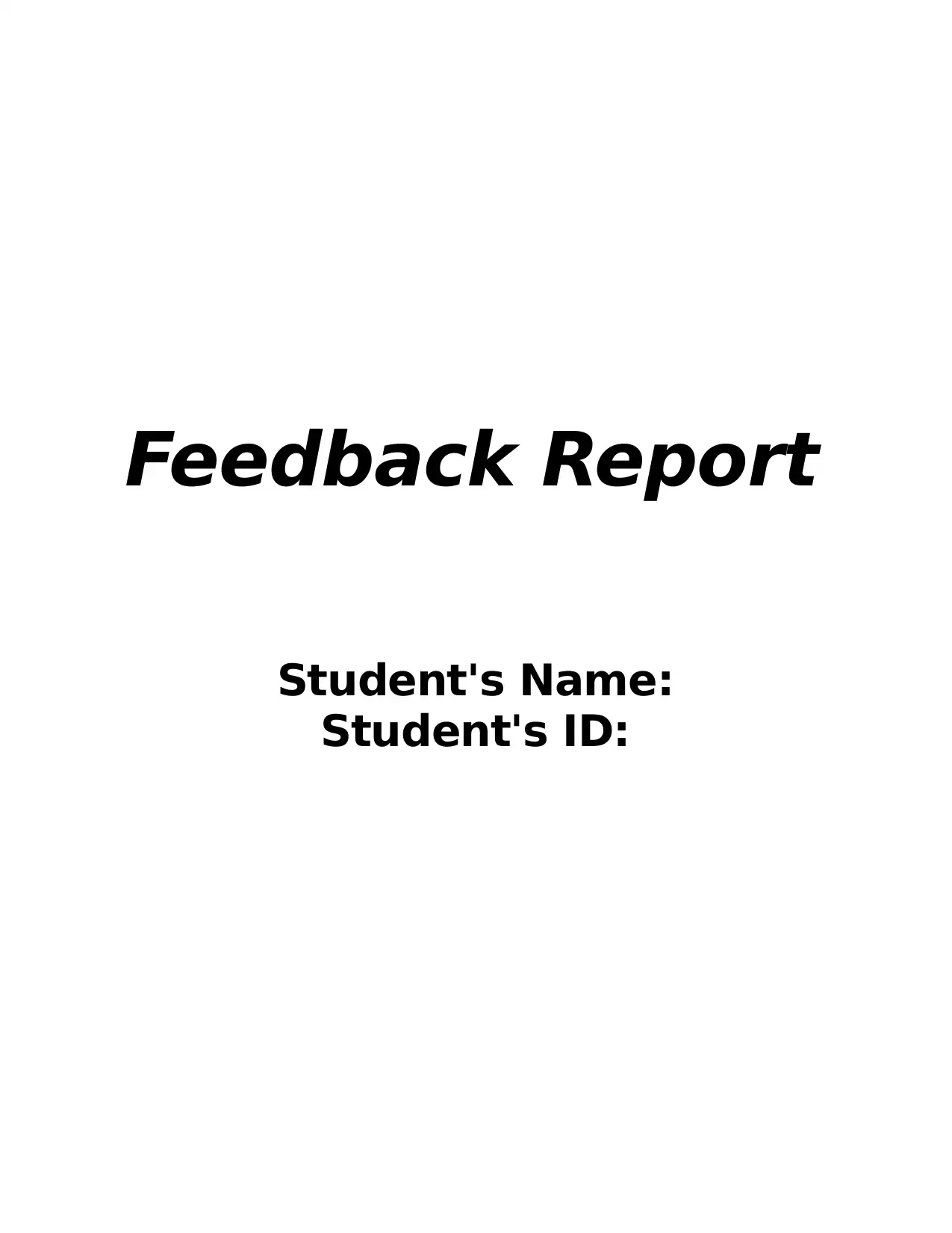
Feedback Report
Student's Name:
Student's ID:
Student's Name:
Student's ID:
Paraphrase This Document
Need a fresh take? Get an instant paraphrase of this document with our AI Paraphraser
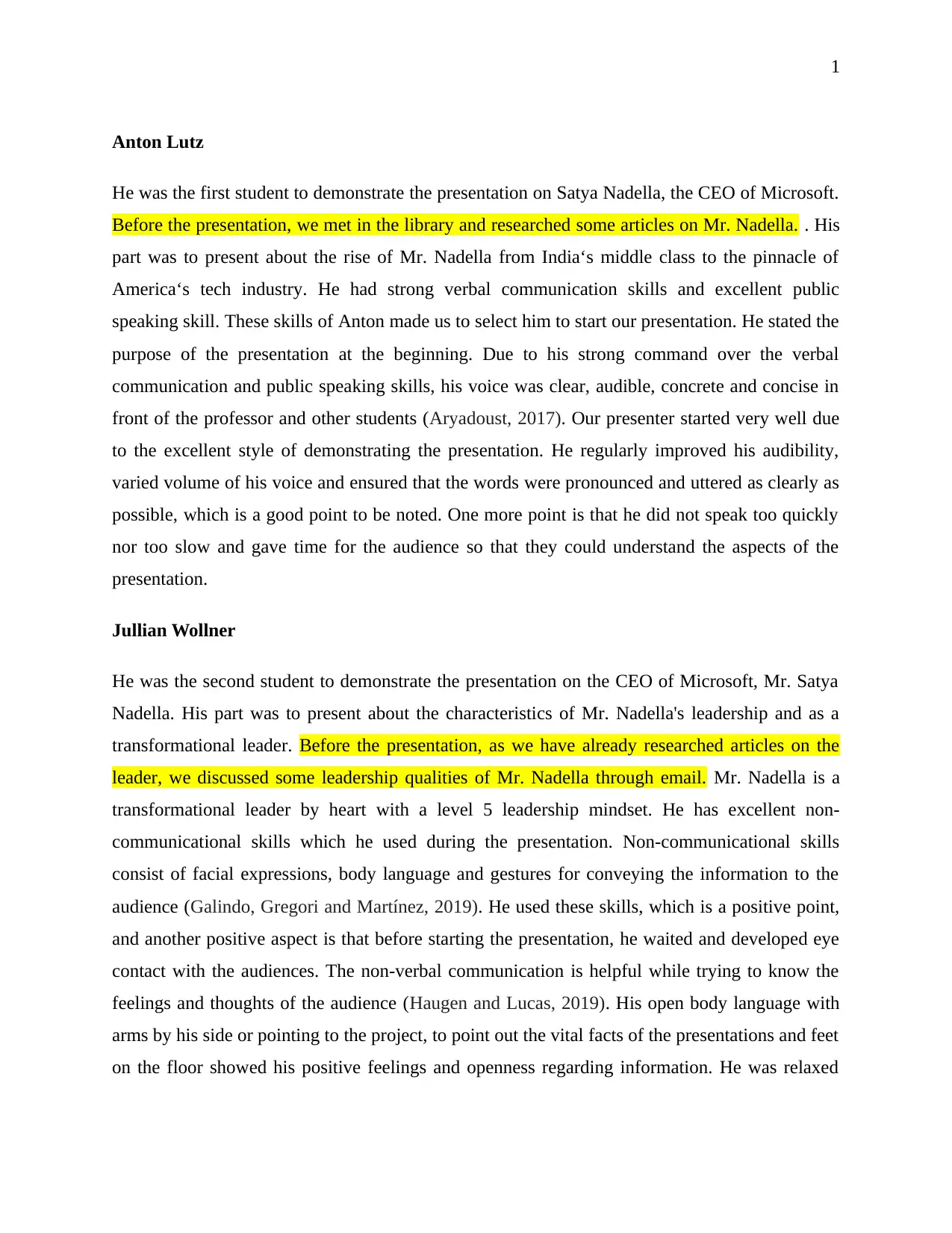
1
Anton Lutz
He was the first student to demonstrate the presentation on Satya Nadella, the CEO of Microsoft.
Before the presentation, we met in the library and researched some articles on Mr. Nadella. . His
part was to present about the rise of Mr. Nadella from India‘s middle class to the pinnacle of
America‘s tech industry. He had strong verbal communication skills and excellent public
speaking skill. These skills of Anton made us to select him to start our presentation. He stated the
purpose of the presentation at the beginning. Due to his strong command over the verbal
communication and public speaking skills, his voice was clear, audible, concrete and concise in
front of the professor and other students (Aryadoust, 2017). Our presenter started very well due
to the excellent style of demonstrating the presentation. He regularly improved his audibility,
varied volume of his voice and ensured that the words were pronounced and uttered as clearly as
possible, which is a good point to be noted. One more point is that he did not speak too quickly
nor too slow and gave time for the audience so that they could understand the aspects of the
presentation.
Jullian Wollner
He was the second student to demonstrate the presentation on the CEO of Microsoft, Mr. Satya
Nadella. His part was to present about the characteristics of Mr. Nadella's leadership and as a
transformational leader. Before the presentation, as we have already researched articles on the
leader, we discussed some leadership qualities of Mr. Nadella through email. Mr. Nadella is a
transformational leader by heart with a level 5 leadership mindset. He has excellent non-
communicational skills which he used during the presentation. Non-communicational skills
consist of facial expressions, body language and gestures for conveying the information to the
audience (Galindo, Gregori and Martínez, 2019). He used these skills, which is a positive point,
and another positive aspect is that before starting the presentation, he waited and developed eye
contact with the audiences. The non-verbal communication is helpful while trying to know the
feelings and thoughts of the audience (Haugen and Lucas, 2019). His open body language with
arms by his side or pointing to the project, to point out the vital facts of the presentations and feet
on the floor showed his positive feelings and openness regarding information. He was relaxed
Anton Lutz
He was the first student to demonstrate the presentation on Satya Nadella, the CEO of Microsoft.
Before the presentation, we met in the library and researched some articles on Mr. Nadella. . His
part was to present about the rise of Mr. Nadella from India‘s middle class to the pinnacle of
America‘s tech industry. He had strong verbal communication skills and excellent public
speaking skill. These skills of Anton made us to select him to start our presentation. He stated the
purpose of the presentation at the beginning. Due to his strong command over the verbal
communication and public speaking skills, his voice was clear, audible, concrete and concise in
front of the professor and other students (Aryadoust, 2017). Our presenter started very well due
to the excellent style of demonstrating the presentation. He regularly improved his audibility,
varied volume of his voice and ensured that the words were pronounced and uttered as clearly as
possible, which is a good point to be noted. One more point is that he did not speak too quickly
nor too slow and gave time for the audience so that they could understand the aspects of the
presentation.
Jullian Wollner
He was the second student to demonstrate the presentation on the CEO of Microsoft, Mr. Satya
Nadella. His part was to present about the characteristics of Mr. Nadella's leadership and as a
transformational leader. Before the presentation, as we have already researched articles on the
leader, we discussed some leadership qualities of Mr. Nadella through email. Mr. Nadella is a
transformational leader by heart with a level 5 leadership mindset. He has excellent non-
communicational skills which he used during the presentation. Non-communicational skills
consist of facial expressions, body language and gestures for conveying the information to the
audience (Galindo, Gregori and Martínez, 2019). He used these skills, which is a positive point,
and another positive aspect is that before starting the presentation, he waited and developed eye
contact with the audiences. The non-verbal communication is helpful while trying to know the
feelings and thoughts of the audience (Haugen and Lucas, 2019). His open body language with
arms by his side or pointing to the project, to point out the vital facts of the presentations and feet
on the floor showed his positive feelings and openness regarding information. He was relaxed
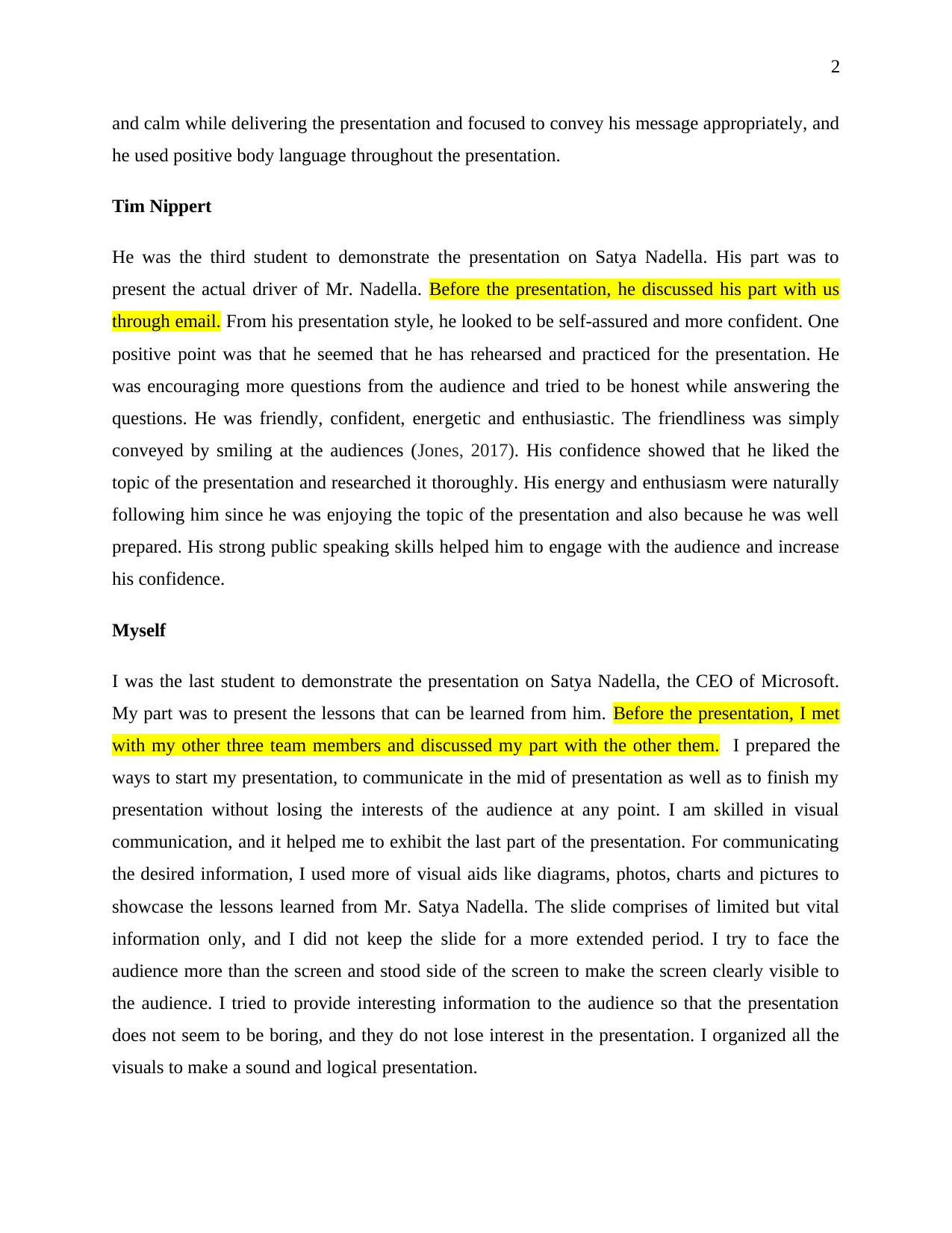
2
and calm while delivering the presentation and focused to convey his message appropriately, and
he used positive body language throughout the presentation.
Tim Nippert
He was the third student to demonstrate the presentation on Satya Nadella. His part was to
present the actual driver of Mr. Nadella. Before the presentation, he discussed his part with us
through email. From his presentation style, he looked to be self-assured and more confident. One
positive point was that he seemed that he has rehearsed and practiced for the presentation. He
was encouraging more questions from the audience and tried to be honest while answering the
questions. He was friendly, confident, energetic and enthusiastic. The friendliness was simply
conveyed by smiling at the audiences (Jones, 2017). His confidence showed that he liked the
topic of the presentation and researched it thoroughly. His energy and enthusiasm were naturally
following him since he was enjoying the topic of the presentation and also because he was well
prepared. His strong public speaking skills helped him to engage with the audience and increase
his confidence.
Myself
I was the last student to demonstrate the presentation on Satya Nadella, the CEO of Microsoft.
My part was to present the lessons that can be learned from him. Before the presentation, I met
with my other three team members and discussed my part with the other them. I prepared the
ways to start my presentation, to communicate in the mid of presentation as well as to finish my
presentation without losing the interests of the audience at any point. I am skilled in visual
communication, and it helped me to exhibit the last part of the presentation. For communicating
the desired information, I used more of visual aids like diagrams, photos, charts and pictures to
showcase the lessons learned from Mr. Satya Nadella. The slide comprises of limited but vital
information only, and I did not keep the slide for a more extended period. I try to face the
audience more than the screen and stood side of the screen to make the screen clearly visible to
the audience. I tried to provide interesting information to the audience so that the presentation
does not seem to be boring, and they do not lose interest in the presentation. I organized all the
visuals to make a sound and logical presentation.
and calm while delivering the presentation and focused to convey his message appropriately, and
he used positive body language throughout the presentation.
Tim Nippert
He was the third student to demonstrate the presentation on Satya Nadella. His part was to
present the actual driver of Mr. Nadella. Before the presentation, he discussed his part with us
through email. From his presentation style, he looked to be self-assured and more confident. One
positive point was that he seemed that he has rehearsed and practiced for the presentation. He
was encouraging more questions from the audience and tried to be honest while answering the
questions. He was friendly, confident, energetic and enthusiastic. The friendliness was simply
conveyed by smiling at the audiences (Jones, 2017). His confidence showed that he liked the
topic of the presentation and researched it thoroughly. His energy and enthusiasm were naturally
following him since he was enjoying the topic of the presentation and also because he was well
prepared. His strong public speaking skills helped him to engage with the audience and increase
his confidence.
Myself
I was the last student to demonstrate the presentation on Satya Nadella, the CEO of Microsoft.
My part was to present the lessons that can be learned from him. Before the presentation, I met
with my other three team members and discussed my part with the other them. I prepared the
ways to start my presentation, to communicate in the mid of presentation as well as to finish my
presentation without losing the interests of the audience at any point. I am skilled in visual
communication, and it helped me to exhibit the last part of the presentation. For communicating
the desired information, I used more of visual aids like diagrams, photos, charts and pictures to
showcase the lessons learned from Mr. Satya Nadella. The slide comprises of limited but vital
information only, and I did not keep the slide for a more extended period. I try to face the
audience more than the screen and stood side of the screen to make the screen clearly visible to
the audience. I tried to provide interesting information to the audience so that the presentation
does not seem to be boring, and they do not lose interest in the presentation. I organized all the
visuals to make a sound and logical presentation.
⊘ This is a preview!⊘
Do you want full access?
Subscribe today to unlock all pages.

Trusted by 1+ million students worldwide
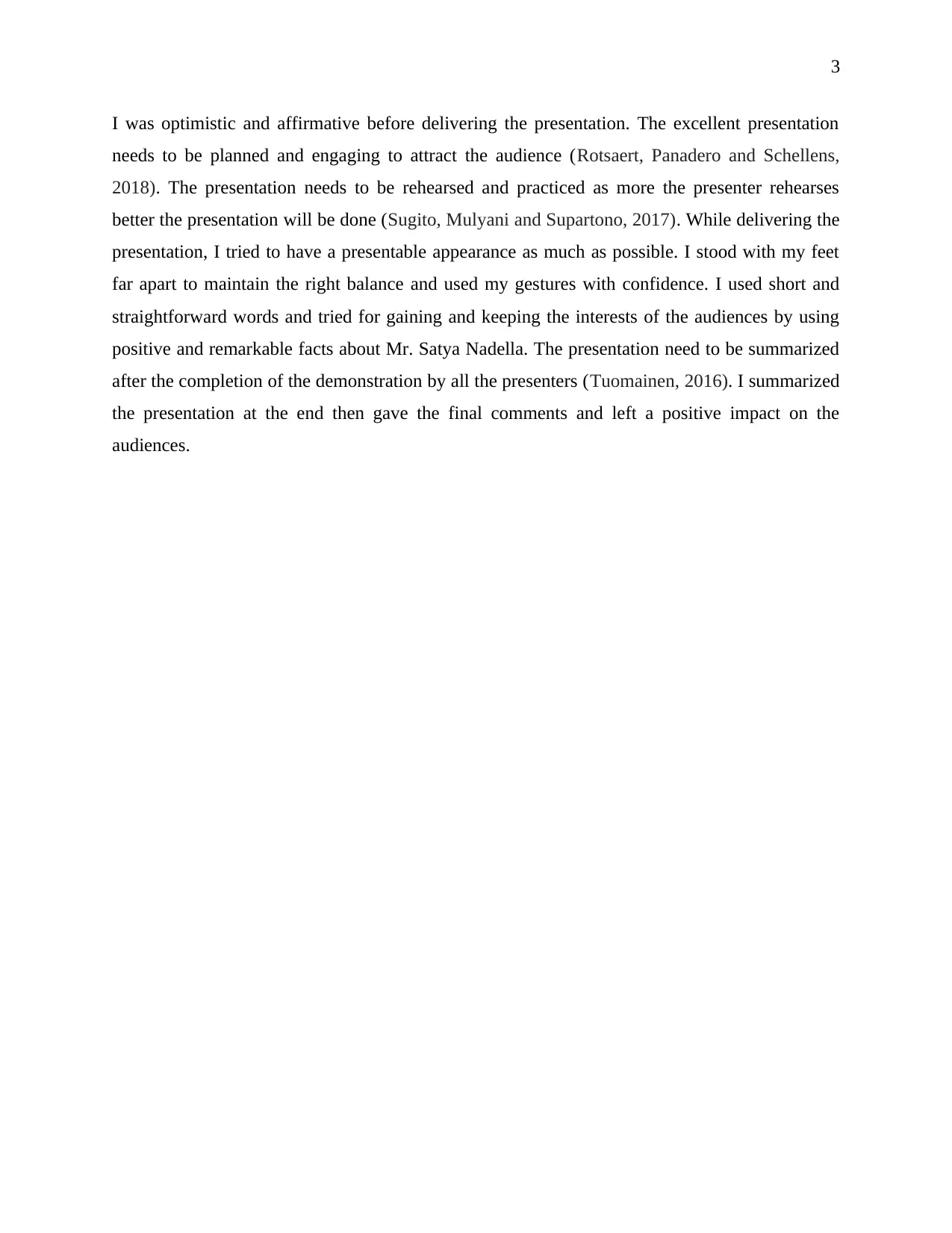
3
I was optimistic and affirmative before delivering the presentation. The excellent presentation
needs to be planned and engaging to attract the audience (Rotsaert, Panadero and Schellens,
2018). The presentation needs to be rehearsed and practiced as more the presenter rehearses
better the presentation will be done (Sugito, Mulyani and Supartono, 2017). While delivering the
presentation, I tried to have a presentable appearance as much as possible. I stood with my feet
far apart to maintain the right balance and used my gestures with confidence. I used short and
straightforward words and tried for gaining and keeping the interests of the audiences by using
positive and remarkable facts about Mr. Satya Nadella. The presentation need to be summarized
after the completion of the demonstration by all the presenters (Tuomainen, 2016). I summarized
the presentation at the end then gave the final comments and left a positive impact on the
audiences.
I was optimistic and affirmative before delivering the presentation. The excellent presentation
needs to be planned and engaging to attract the audience (Rotsaert, Panadero and Schellens,
2018). The presentation needs to be rehearsed and practiced as more the presenter rehearses
better the presentation will be done (Sugito, Mulyani and Supartono, 2017). While delivering the
presentation, I tried to have a presentable appearance as much as possible. I stood with my feet
far apart to maintain the right balance and used my gestures with confidence. I used short and
straightforward words and tried for gaining and keeping the interests of the audiences by using
positive and remarkable facts about Mr. Satya Nadella. The presentation need to be summarized
after the completion of the demonstration by all the presenters (Tuomainen, 2016). I summarized
the presentation at the end then gave the final comments and left a positive impact on the
audiences.
Paraphrase This Document
Need a fresh take? Get an instant paraphrase of this document with our AI Paraphraser
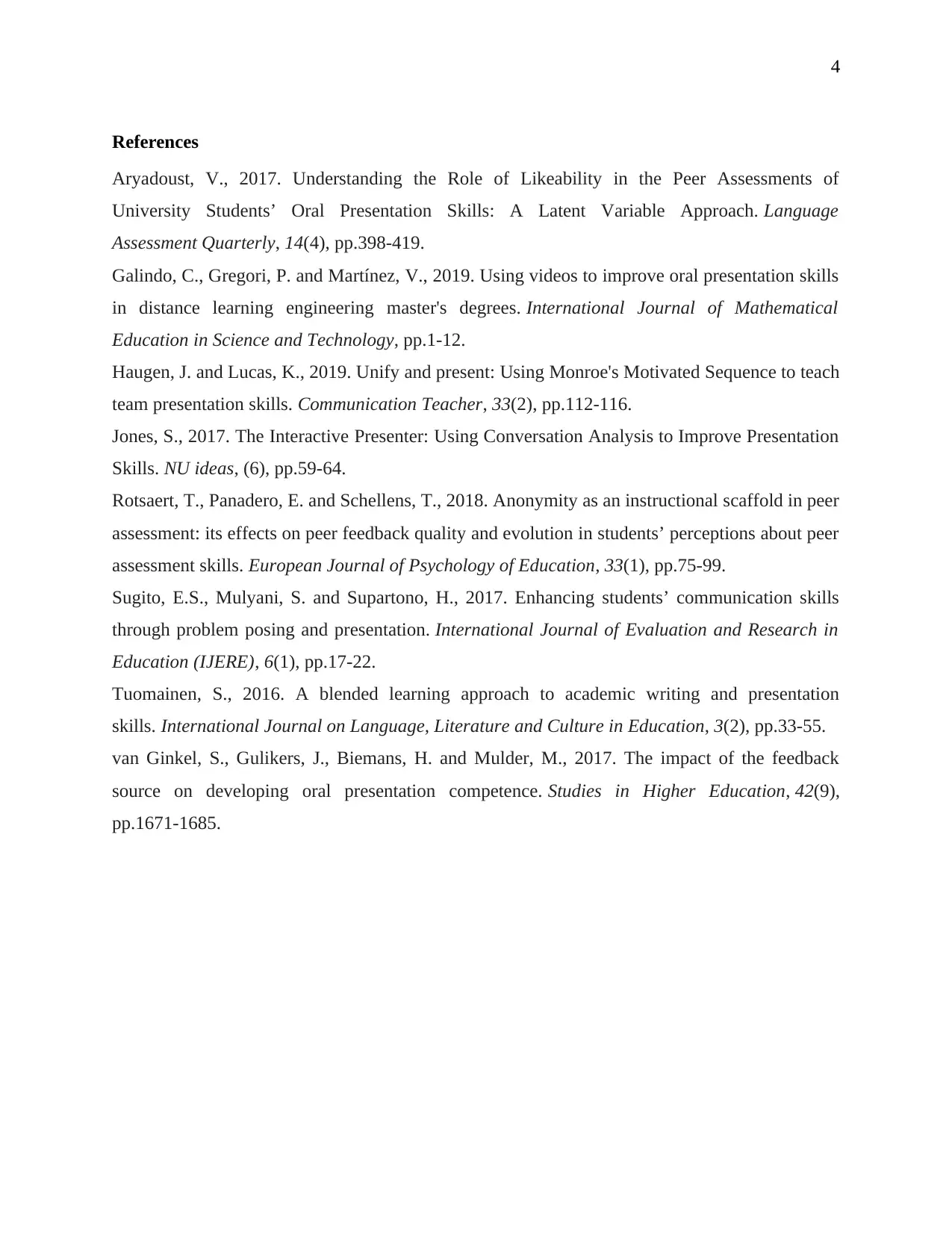
4
References
Aryadoust, V., 2017. Understanding the Role of Likeability in the Peer Assessments of
University Students’ Oral Presentation Skills: A Latent Variable Approach. Language
Assessment Quarterly, 14(4), pp.398-419.
Galindo, C., Gregori, P. and Martínez, V., 2019. Using videos to improve oral presentation skills
in distance learning engineering master's degrees. International Journal of Mathematical
Education in Science and Technology, pp.1-12.
Haugen, J. and Lucas, K., 2019. Unify and present: Using Monroe's Motivated Sequence to teach
team presentation skills. Communication Teacher, 33(2), pp.112-116.
Jones, S., 2017. The Interactive Presenter: Using Conversation Analysis to Improve Presentation
Skills. NU ideas, (6), pp.59-64.
Rotsaert, T., Panadero, E. and Schellens, T., 2018. Anonymity as an instructional scaffold in peer
assessment: its effects on peer feedback quality and evolution in students’ perceptions about peer
assessment skills. European Journal of Psychology of Education, 33(1), pp.75-99.
Sugito, E.S., Mulyani, S. and Supartono, H., 2017. Enhancing students’ communication skills
through problem posing and presentation. International Journal of Evaluation and Research in
Education (IJERE), 6(1), pp.17-22.
Tuomainen, S., 2016. A blended learning approach to academic writing and presentation
skills. International Journal on Language, Literature and Culture in Education, 3(2), pp.33-55.
van Ginkel, S., Gulikers, J., Biemans, H. and Mulder, M., 2017. The impact of the feedback
source on developing oral presentation competence. Studies in Higher Education, 42(9),
pp.1671-1685.
References
Aryadoust, V., 2017. Understanding the Role of Likeability in the Peer Assessments of
University Students’ Oral Presentation Skills: A Latent Variable Approach. Language
Assessment Quarterly, 14(4), pp.398-419.
Galindo, C., Gregori, P. and Martínez, V., 2019. Using videos to improve oral presentation skills
in distance learning engineering master's degrees. International Journal of Mathematical
Education in Science and Technology, pp.1-12.
Haugen, J. and Lucas, K., 2019. Unify and present: Using Monroe's Motivated Sequence to teach
team presentation skills. Communication Teacher, 33(2), pp.112-116.
Jones, S., 2017. The Interactive Presenter: Using Conversation Analysis to Improve Presentation
Skills. NU ideas, (6), pp.59-64.
Rotsaert, T., Panadero, E. and Schellens, T., 2018. Anonymity as an instructional scaffold in peer
assessment: its effects on peer feedback quality and evolution in students’ perceptions about peer
assessment skills. European Journal of Psychology of Education, 33(1), pp.75-99.
Sugito, E.S., Mulyani, S. and Supartono, H., 2017. Enhancing students’ communication skills
through problem posing and presentation. International Journal of Evaluation and Research in
Education (IJERE), 6(1), pp.17-22.
Tuomainen, S., 2016. A blended learning approach to academic writing and presentation
skills. International Journal on Language, Literature and Culture in Education, 3(2), pp.33-55.
van Ginkel, S., Gulikers, J., Biemans, H. and Mulder, M., 2017. The impact of the feedback
source on developing oral presentation competence. Studies in Higher Education, 42(9),
pp.1671-1685.
1 out of 5
Related Documents
Your All-in-One AI-Powered Toolkit for Academic Success.
+13062052269
info@desklib.com
Available 24*7 on WhatsApp / Email
![[object Object]](/_next/static/media/star-bottom.7253800d.svg)
Unlock your academic potential
Copyright © 2020–2025 A2Z Services. All Rights Reserved. Developed and managed by ZUCOL.





